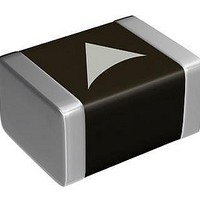B72542V3140S272 EPCOS Inc, B72542V3140S272 Datasheet - Page 12

B72542V3140S272
Manufacturer Part Number
B72542V3140S272
Description
Varistors - MLV Varistor CN2220S14BAUTOE2G2K2
Manufacturer
EPCOS Inc
Datasheet
1.B72542V3140S272.pdf
(16 pages)
Specifications of B72542V3140S272
Voltage Rating Dc
16 V
Voltage Rating Ac
14 V
Clamping Voltage
40 V
Peak Surge Current
1200 A
Surge Energy Rating
5.8 J
Capacitance
15 nF
Operating Temperature Range
- 55 C to + 125 C
Dimensions
5 mm W x 5.7 mm L x 2.3 mm H
Mounting
SMD/SMT
Package / Case
2220
Lead Free Status / RoHS Status
Lead free / RoHS Compliant
Cautions and warnings
General
Some parts of this publication contain statements about the suitability of our ceramic transient voltage
suppressor (CTVS) components (multilayer varistors (MLVs), CeraDiodes, ESD/EMI filters, SMD disk
varistors (CU types), leaded transient voltage/ RFI suppressors (SHCV types)) for certain areas of
application, including recommendations about incorporation/design-in of these products into customer
applications. The statements are based on our knowledge of typical requirements often made of our
CTVS devices in the particular areas. We nevertheless expressly point out that such statements
cannot be regarded as binding statements about the suitability of our CTVS components for a
particular customer application. As a rule, EPCOS is either unfamiliar with individual customer
applications or less familiar with them than the customers themselves. For these reasons, it is always
incumbent on the customer to check and decide whether the CTVS devices with the properties
described in the product specification are suitable for use in a particular customer application.
Design notes
PPD ML PD
Please read Cautions and warnings and
Important notes at the end of this document.
Ceramic transient voltage suppressors
SMD multilayer varistor with AgPt termination
•
•
•
•
•
•
•
•
•
Do not use EPCOS CTVS components for purposes not identified in our specifications,
application notes and data books.
Ensure the suitability of a CTVS in particular by testing it for reliability during design-in.
Always evaluate a CTVS component under worst-case conditions.
Pay special attention to the reliability of CTVS devices intended for use in safety-critical
applications (e.g. medical equipment, automotive, spacecraft, nuclear power plant).
Always connect a CTVS in parallel with the electronic circuit to be protected.
Consider maximum rated power dissipation if a CTVS has insufficient time to cool down
between a number of pulses occurring within a specified isolated time period. Ensure that
electrical characteristics do not degrade.
Consider derating at higher operating temperatures. Choose the highest voltage class
compatible with derating at higher temperatures.
Surge currents beyond specified values will puncture a CTVS. In extreme cases a CTVS will
burst.
If steep surge current edges are to be expected, make sure your design is as low-inductance
as possible.
In some cases the malfunctioning of passive electronic components or failure before the end
of their service life cannot be completely ruled out in the current state of the art, even if they
are operated as specified. In applications requiring a very high level of operational safety and
especially when the malfunction or failure of a passive electronic component could endanger
human life or health (e.g. in accident prevention, life-saving systems, or automotive battery
line applications such as clamp 30), ensure by suitable design of the application or other
measures (e.g. installation of protective circuitry or redundancy) that no injury or damage is
sustained by third parties in the event of such a malfunction or failure. Only use CTVS
components from the AUTO series in safety-relevant applications.
Page 12 of 16
CN2220S14BAUTOE2G2K2
B72542V3140S272
2010-01-20












